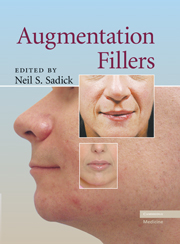Book contents
- Frontmatter
- Contents
- LIST OF CONTRIBUTORS
- Ch. 1 Application of Fillers
- Ch. 2 Approach to Choosing the Ideal Filler
- Ch. 3 Patient Selection, Counseling, and Informed Consent
- Ch. 4 Hyaluronic Acid Skin Derivatives
- Ch. 5 Collagen Products
- Ch. 6 Radiesse
- Ch. 7 ArteFill
- Ch. 8 Augmentation Fillers in Cosmetic Dermatology: Silicone
- Ch. 9 Advanta Expanded Polytetrafluoroethylene Implants
- Ch. 10 Sculptra
- Ch. 11 Lipo Transfer
- Ch. 12 BioAlcamid®
- Ch. 13 Combination of Approaches in Augmentation Fillers in Cosmetic Dermatology
- Ch. 14 Filling Complications
- Ch. 15 Postprocedure Management and Patient Instructions
- Ch. 16 Conclusion: Future Trends in Fillers
- INDEX
- References
Ch. 7 - ArteFill
Published online by Cambridge University Press: 26 February 2010
- Frontmatter
- Contents
- LIST OF CONTRIBUTORS
- Ch. 1 Application of Fillers
- Ch. 2 Approach to Choosing the Ideal Filler
- Ch. 3 Patient Selection, Counseling, and Informed Consent
- Ch. 4 Hyaluronic Acid Skin Derivatives
- Ch. 5 Collagen Products
- Ch. 6 Radiesse
- Ch. 7 ArteFill
- Ch. 8 Augmentation Fillers in Cosmetic Dermatology: Silicone
- Ch. 9 Advanta Expanded Polytetrafluoroethylene Implants
- Ch. 10 Sculptra
- Ch. 11 Lipo Transfer
- Ch. 12 BioAlcamid®
- Ch. 13 Combination of Approaches in Augmentation Fillers in Cosmetic Dermatology
- Ch. 14 Filling Complications
- Ch. 15 Postprocedure Management and Patient Instructions
- Ch. 16 Conclusion: Future Trends in Fillers
- INDEX
- References
Summary
INTRODUCTION
The demand for safe, effective, long-lasting, and biocompatible dermal filler materials is increasing as a growing number of patients seek minimally invasive options for aesthetic improvement. For a substance or device to be amenable for soft tissue augmentation, in addition to producing the desired cosmetic results, the product must be well tolerated, exhibit a minimum of undesirable reactions, and be nonteratogenic, noncarcinogenic, and nonmigratory. In addition, the material or device must be easy to use and provide predictable, persistent correction through reproducible implantation techniques. Finally, in the United States, the Food and Drug Administration (FDA) review and approval of such products not only substantiates they meet safety and efficacy requirements but also assures adherence to important manufacturing and product labeling requirements postapproval.
Numerous attempts have been made to develop safe biological (e.g., collagen, hyaluronic acid) or synthetic (man-made) materials to fill unwanted wrinkles and scars. Currently, in the United States, there are about twelve or more different soft tissue fillers approved for cosmetic use; in Europe, there are approximately eighty CE marked approved cosmetic fillers with many more available worldwide. Historically, biologic filler materials that use “natural-based” core substances such as collagen and hyaluronic acid materials have predominated the marketplace. These materials, whether they are derived from a bioengineered or extracted from a natural source, typically have been modified to improve tolerability (e.g., removal of impurities) and modified to improve durability (e.g., cross-linked).
- Type
- Chapter
- Information
- Augmentation Fillers , pp. 53 - 68Publisher: Cambridge University PressPrint publication year: 2010



